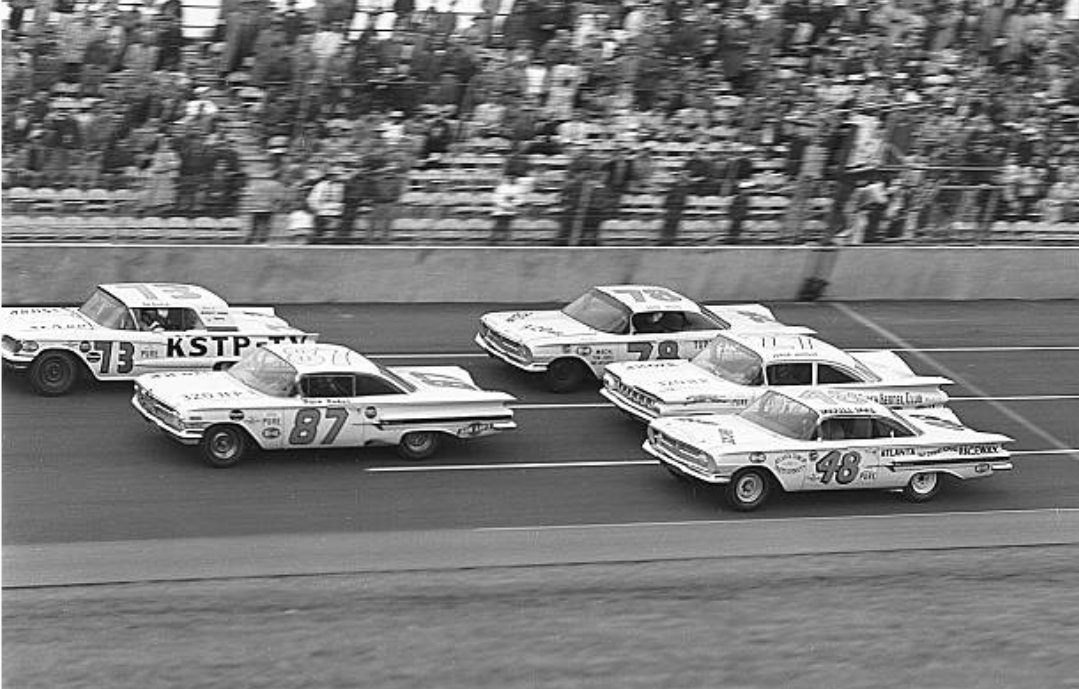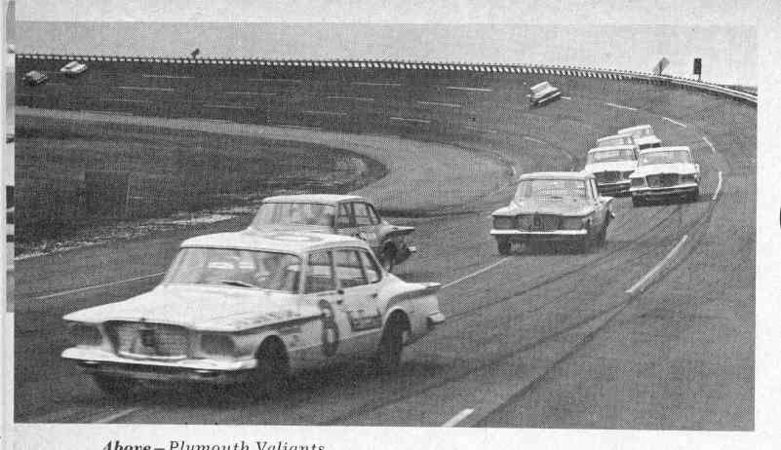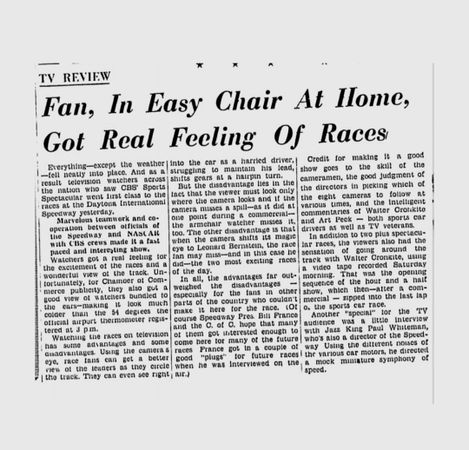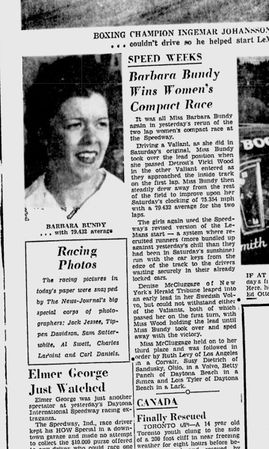1960 Daytona Races (partially found footage of NASCAR prelude events to Daytona 500; 1960): Difference between revisions
No edit summary |
No edit summary |
||
| Line 47: | Line 47: | ||
</gallery> | </gallery> | ||
==See Also (Early Sports Television Media | ==See Also== | ||
===NASCAR Media=== | |||
*[[1971 Twin 125s (lost footage of NASCAR Daytona 500 qualifying races; 1971)]] | |||
*[[1974 Twin 125s (lost footage of NASCAR Daytona 500 qualifying races; 1974)]] | |||
*[[1975 Twin 125s (lost footage of NASCAR Daytona 500 qualifying races; 1975)]] | |||
*[[1976 Dixie 500 (lost CBS footage of NASCAR Winston Cup Series race; 1976)]] | |||
*[[1979 Southeastern 500 (partially found footage of NASCAR Winston Cup Series race; 1979)]] | |||
*[[1982 Twin 125s race 1 (lost footage of NASCAR Daytona 500 qualifying race; existence unconfirmed; 1982)]] | |||
*[[1984 Delaware 500 (partially found footage of NASCAR Winston Cup Series race; 1984)]] | |||
*[[1984 Warner W. Hodgdon Carolina 500 (lost footage of NASCAR Winston Cup Series race; existence unconfirmed; 1984)]] | |||
*[[1985 Twin 125s (lost footage of NASCAR Daytona 500 qualifying races; existence unconfirmed; 1985)]] | |||
*[[1986 Twin 125s (lost footage of NASCAR Daytona 500 qualifying races; existence unconfirmed; 1986)]] | |||
*[[1996 DeVilbiss SuperFinish 200 (partially found televised footage of NASCAR Craftsman Truck Series race; 1996)]] | |||
===Early Sports Television Media=== | |||
*[[1931 Epsom Derby (lost televised footage of horse racing event; 1931)]] | *[[1931 Epsom Derby (lost televised footage of horse racing event; 1931)]] | ||
*[[1934 Philo T. Farnsworth broadcasts (lost early television demonstrations; 1934)]] | *[[1934 Philo T. Farnsworth broadcasts (lost early television demonstrations; 1934)]] | ||
| Line 58: | Line 72: | ||
*[[1938 Pennsylvania Quakers football season (lost early televised college football games; 1938)]] | *[[1938 Pennsylvania Quakers football season (lost early televised college football games; 1938)]] | ||
*[[1939 FA Cup Final (partially found footage of football match; 1939)]] | *[[1939 FA Cup Final (partially found footage of football match; 1939)]] | ||
*[[1947 FA Cup Final (partially found footage of football match; 1947)]] | |||
*[[1953 British Grand Prix (partially found footage of Formula One race; 1953)]] | *[[1953 British Grand Prix (partially found footage of Formula One race; 1953)]] | ||
*[[Arsenal vs Arsenal Reserves (lost footage of early BBC televised football match; 1937)]] | *[[Arsenal vs Arsenal Reserves (lost footage of early BBC televised football match; 1937)]] | ||
*[[Barnet 3-2 Wealdstone (lost footage of Athenian League football match; 1946)]] | |||
*[[Bill Longson vs Whipper Billy Watson (lost footage of professional wrestling match; 1947)]] | |||
*[[Brooklyn Dodgers 2-5 6-1 Cincinnati Reds (lost footage of MLB doubleheader; 1939)]] | *[[Brooklyn Dodgers 2-5 6-1 Cincinnati Reds (lost footage of MLB doubleheader; 1939)]] | ||
*[[Brooklyn Dodgers 23-14 Philadelphia Eagles (lost footage of NFL game; 1939)]] | *[[Brooklyn Dodgers 23-14 Philadelphia Eagles (lost footage of NFL game; 1939)]] | ||
*[[Catch-As-Catch-Can Wrestling (lost early BBC televised professional wrestling matches; 1938-1939; 1946-1947)]] | *[[Catch-As-Catch-Can Wrestling (lost early BBC televised professional wrestling matches; 1938-1939; 1946-1947)]] | ||
*[[Charlton Athletic 1-0 Blackburn Rovers (lost footage of FA Cup match; 1947)]] | |||
*[[Columbia Lions 1-2 Princeton Tigers (partially found footage of college baseball game; 1939)]] | *[[Columbia Lions 1-2 Princeton Tigers (partially found footage of college baseball game; 1939)]] | ||
*[[Darts and Shove Ha'penny (lost early BBC televised darts matches; 1936-1939)]] | *[[Darts and Shove Ha'penny (lost early BBC televised darts matches; 1936-1939)]] | ||
*[[England 0-1 Scotland (partially found international football match; 1938)]] | *[[England 0-1 Scotland (partially found international football match; 1938)]] | ||
*[[England 16-21 Scotland (partially found footage of rugby match; 1938)]] | *[[England 16-21 Scotland (partially found footage of rugby match; 1938)]] | ||
*[[England 3-0 Rest of Europe (partially found footage of international football match; 1938)]] | |||
*[[Fordham Rams 34-7 Waynesburg Yellow Jackets (lost footage of college football game; 1939)]] | *[[Fordham Rams 34-7 Waynesburg Yellow Jackets (lost footage of college football game; 1939)]] | ||
*[[Indianapolis 500 WFBM-TV Broadcasts (lost racing footage; 1949-1950)]] | *[[Indianapolis 500 WFBM-TV Broadcasts (lost racing footage; 1949-1950)]] | ||
*[[Juventus 1-7 A.C. Milan (partially found footage of Serie A football match; 1950)]] | |||
*[[The Boat Race 1938 (partially found footage of rowing race; 1938)]] | *[[The Boat Race 1938 (partially found footage of rowing race; 1938)]] | ||
==External Link== | ==External Link== | ||
Revision as of 17:43, 3 January 2022
On 31st January, 1960, the pole position race for the Daytona 500 and compact car events commenced. Serving as the prelude to the main event on 14th February, these races became part of television history, as they were the first NASCAR races to be televised.
Background
Heading into the Daytona 500 on 14th February, a variety of races were set to commence as part of Speedweeks. On 31st January, the Grand National Pole Position race would commence to decide the front row for the Daytona 500. Other events, including a compact car race, a 2-lap women's compact car event, and a Le Mans start sports car event would also be conducted. CBS therefore decided that these races would be perfect to televise. Not only would it provide comprehensive racing coverage, but it would also give CBS the opportunity to learn how to properly cover racing events, which back then were notably difficult to capture for television.
Thus, with the broadcast being produced by Hugh Beach, the network sent a crew of over 50 to cover the event, and it would be broadcast as part of CBS Sports Spectacular.[1] Among the crew included Walter Cronkite, a CBS anchorman who had competed in sport car events, included the 1959 12 Hours of Sebring. Also present was Art Beck, CBS' director for network operations and fellow sports car enthusiast.[2] The pits interviewer was Bud Palmer, who would also provide occasional colour commentary according to Racing-Reference. However, other sources claim he was the host. [3]
CBS decided to first capture some races held on the 30th, so as to provide filler in the case of a lack of action on Sunday. The Sunday broadcast was expected to attract around 17 million viewers, which ultimately turned out to be correct.[4] As a result of the broadcast's success, a few NASCAR races would be televised throughout the 1960s, before more regular broadcasts began during the 1970s. CBS would also start to televise NASCAR events in the next few decades, starting with the 1979 Daytona 500, CBS' broadcast being the first flag-to-flag coverage of the race.[5]
The Broadcast
Racing-References's nascarman History provides a detailed report of what was broadcast by CBS. The Sunday broadcast began at 15:00, and lasted for an hour and half. It started with a tape of Cronkite driving a Lotus Xi at a top speed of 130mph across the Daytona Speedway.[6] As something that would become a regular feature of not just NASCAR, but for motor racing as a whole, Cronkite would commentate as he drove along the Speedway, with footage being recorded from the passenger's seat with the intention to give the audience a feeling of just how quick the vehicles could go at Daytona. Following this, the final lap of an SCCA Regional sports car race was shown live, Ed Rahal being victorious in a 1957 Jaguar D-Type, following on from his first at the Speedway on 5th September, 1959.[7]
The main event for the broadcast would be the first of Daytona 500's two qualifying races. This one would help decide the pole position for the 500. In a 10-lap race pitting Cotton Owens, Jack Smith, Fireball Roberts, and Bobby Johns, it ultimately saw Owens in a Pontiac become victorious after having overtaken Smith via the bottom of the backstretch to win via a car length on the final lap.[8][9]
The next two races featured Le Mans starts, which is a type of standing start where the driver must run to the other side of the track, unlock their car, get in and start their machine, before driving away to start the race.[10] The first was a women's compact race, essentially a re-do of a women's race held on Saturday. Denise McCluggage went into the lead with her Volvo at the start, but would be passed by the Plymouth Valiants of Vicki Wood and Barbara Bundy at turn one. Bundy would then overtake Wood just before the inside track on lap 1, and would comfortably remain in the lead for the rest of the race, ahead of Wood and McCluggage.[11]
The other race featuring a Le Mans start was a one-lap men's sports car event, this time focusing on mainly on the Le Mans gimmick with Rahal also winning this event. The final race televised by CBS was the first of two men's compact races. Like with the women's event, the Plymouth Valiants proved to be the fastest, with Marvin Panch dominating the race from start to finish to claim victory and earn $1,900 in prize money, more than $17,500 when adjusted for modern inflation.
12th February NBC Broadcast
In addition to CBS' ground-breaking broadcast, NBC also hastily decided to broadcast an event at Daytona that same year. On 12th February, NBC televised the Autolite Challenge Race, a sprint that the Autolite themselves would be in control of by selecting the drivers that would compete. Sources conflict on its length; The Earnhardts: A Biography states that it was a four-mile ten-lap event,[12] whereas Stock Car Racing History claims it was 10-miles and only four laps for a total broadcast time of five minutes. Regardless, it was televised on NBC as part of NBC's Today via tape delay, with Johnny Beauchamp winning after having narrowly passed Ned Jarrett and winning by an inch.[13]
Availability
While newsreel footage of the compact race is publicly available, the CBS broadcast is now considered lost media. According to Racing-Reference, a kinetoscope of the broadcast may still exist,[14] though the chances of it or any CBS film of the event being recovered is now intensely slim. This is because tapes of recorded television events back then were usually wiped and reused due to the intense cost of storing them.[15] The NBC footage has likely suffered the same fate.
Gallery
Video
Images
See Also
NASCAR Media
- 1971 Twin 125s (lost footage of NASCAR Daytona 500 qualifying races; 1971)
- 1974 Twin 125s (lost footage of NASCAR Daytona 500 qualifying races; 1974)
- 1975 Twin 125s (lost footage of NASCAR Daytona 500 qualifying races; 1975)
- 1976 Dixie 500 (lost CBS footage of NASCAR Winston Cup Series race; 1976)
- 1979 Southeastern 500 (partially found footage of NASCAR Winston Cup Series race; 1979)
- 1982 Twin 125s race 1 (lost footage of NASCAR Daytona 500 qualifying race; existence unconfirmed; 1982)
- 1984 Delaware 500 (partially found footage of NASCAR Winston Cup Series race; 1984)
- 1984 Warner W. Hodgdon Carolina 500 (lost footage of NASCAR Winston Cup Series race; existence unconfirmed; 1984)
- 1985 Twin 125s (lost footage of NASCAR Daytona 500 qualifying races; existence unconfirmed; 1985)
- 1986 Twin 125s (lost footage of NASCAR Daytona 500 qualifying races; existence unconfirmed; 1986)
- 1996 DeVilbiss SuperFinish 200 (partially found televised footage of NASCAR Craftsman Truck Series race; 1996)
Early Sports Television Media
- 1931 Epsom Derby (lost televised footage of horse racing event; 1931)
- 1934 Philo T. Farnsworth broadcasts (lost early television demonstrations; 1934)
- 1936 Summer Olympics (lost television coverage of Berlin Games; 1936)
- 1937 FA Cup Final (partially found footage of football match; 1937)
- 1937 International Imperial Trophy Race (lost footage of motor race; 1937)
- 1937 Wimbledon Championships (partially found footage of tennis tournament; 1937)
- 1938 Ashes Series (partially found footage of international test cricket match; 1938)
- 1938 FA Cup Final (partially found footage of football match; 1938)
- 1938 Pennsylvania Quakers football season (lost early televised college football games; 1938)
- 1939 FA Cup Final (partially found footage of football match; 1939)
- 1947 FA Cup Final (partially found footage of football match; 1947)
- 1953 British Grand Prix (partially found footage of Formula One race; 1953)
- Arsenal vs Arsenal Reserves (lost footage of early BBC televised football match; 1937)
- Barnet 3-2 Wealdstone (lost footage of Athenian League football match; 1946)
- Bill Longson vs Whipper Billy Watson (lost footage of professional wrestling match; 1947)
- Brooklyn Dodgers 2-5 6-1 Cincinnati Reds (lost footage of MLB doubleheader; 1939)
- Brooklyn Dodgers 23-14 Philadelphia Eagles (lost footage of NFL game; 1939)
- Catch-As-Catch-Can Wrestling (lost early BBC televised professional wrestling matches; 1938-1939; 1946-1947)
- Charlton Athletic 1-0 Blackburn Rovers (lost footage of FA Cup match; 1947)
- Columbia Lions 1-2 Princeton Tigers (partially found footage of college baseball game; 1939)
- Darts and Shove Ha'penny (lost early BBC televised darts matches; 1936-1939)
- England 0-1 Scotland (partially found international football match; 1938)
- England 16-21 Scotland (partially found footage of rugby match; 1938)
- England 3-0 Rest of Europe (partially found footage of international football match; 1938)
- Fordham Rams 34-7 Waynesburg Yellow Jackets (lost footage of college football game; 1939)
- Indianapolis 500 WFBM-TV Broadcasts (lost racing footage; 1949-1950)
- Juventus 1-7 A.C. Milan (partially found footage of Serie A football match; 1950)
- The Boat Race 1938 (partially found footage of rowing race; 1938)
External Link
References
- ↑ ESPN countdown stating that the event was broadcast as part of CBS Sports Spectacular. Retrieved 17 Oct '21
- ↑ Television review for the CBS broadcast, noting Walter Cronkite and Art Beck's enthusiasm for sports cars. Retrieved 17 Oct '21
- ↑ Richard Petty: The Cars of the King crediting Bud Palmer as the host for the event. Retrieved 17 Oct '21
- ↑ 1001 NASCAR Facts: Cars, Tracks, Milestones, Personalities stating the broadcast drew around 17 million viewers. Retrieved 17 Oct '21
- ↑ Fox Sports crediting the 1979 Daytona 500 broadcast as the first flag-to-flag coverage of the event. Retrieved 17 Oct '21
- ↑ Road and Track detailing Walter Cronkite's drive along the Daytona Speedway. Retrieved 17 Oct '21
- ↑ Vintage Racecar noting Ed Rahal's SSCA Regional sports car win. Retrieved 17 Oct '21
- ↑ Cotton Owens Garage noting Owens was on pole for the 1960 Daytona 500 as a result of this qualifying race. Retrieved 17 Oct '21
- ↑ Gettyimages providing a photo of Owens being congratulated for earning the pole position. Retrieved 17 Oct '21
- ↑ Car Magazine defining a Le Mans start. Retrieved 17 Oct '21
- ↑ Newspaper clipping detailing the women's compact race. Retrieved 17 Oct '21
- ↑ The Earnhardts: A Biography detailing the NBC broadcast. Retrieved 17 Oct '21
- ↑ Stock Car Racing History detailing the NBC broadcast and the Autolite Challenge Race result. Retrieved 17 Oct '21
- ↑ Racing-Reference detailing how a kinetoscope of the broadcast may still potentially exist. Retrieved 17 Oct '21
- ↑ Old Time Review detailing the practice of wiping. Retrieved 17 Oct '21



